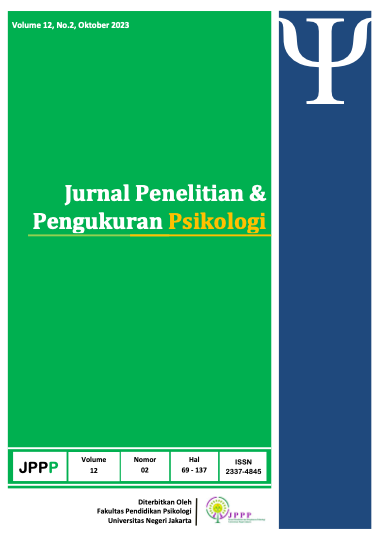Pengaruh Cyberbullying terhadap Self-Blaming pada Remaja Pengguna Instagram
DOI:
https://doi.org/10.21009/JPPP.122.07Keywords:
Cyberbullying, Self-blaming, Instagram, AdolescentsAbstract
Technological developments make it easier for humans to network widely through social media such as Instagram. Active Instagram users in Indonesia are dominated by teenagers. The existence of social media allows cyberbullying to occur, which is an act of bullying via the internet that can trigger victims to blame themselves. The purpose of this study was to determine the effect of cyberbullying on adolescents who experience self-blaming via Instagram. The method used in this study is quantitative with a non-experimental regression approach. The data collection technique was carried out using an instrument in the form of a Likert scale, while the data collection method was through a questionnaire filled out via the Google form. Participants in this study were young Instagram users aged 18-22 years. Based on the results of the simple regression test that has been carried out by researchers, it can be concluded that cyberbullying has a significant effect on self-blaming. After conducting this research, it is hoped that further researchers can intervene through education on social media such as distributing e-flyers related to cyberbullying behavior so that they can suppress cyberbullying actions that occur on social media.
References
Asosiasi Penyelenggara Jasa Internet Indonesia. (2016). Penetrasi dan perilaku pengguna internet Indonesia.Diakses dari. https://apjii.or.id/surveipenetrasiinternet2016.pdf.
Asosiasi Penyelenggara Jasa Internet Indonesia. (2017). Penetrasi dan perilaku pengguna internet indonesia 2017.
Burhan, B. 2011. Metodologi Penelitian Kuantitatif. DKI Jakarta: Persada Media.
Barak, A. (2008). Psychological Aspects of Cyberspace: Theory, Research, Applications. New York: Cambridge University Press.
Camfield, D.C. (2006). Cyberbullying and Victimization: Psychologica l characteristics of bullies, victims and bully/victims. Theses, Disertations, professional Papers.
Janoff-Bulman, R. (2010). Characterological versus behavioral self-blame: Inquiries into depression and rape. Journal of Personality and Social Psychology, 37(10), 1798-1809. doi:10.1037/0022-3514.37.10.1798.
Lu, J., Hao, Q. & Jing, M. (2016). Consuming, sharing, and creating content: How young students use new social media in and outside school. Computers in Human Behavior, 64, 55-64.
Mandau, M. B. H. (2020). ‘Directly in your face’: A qualitative study on the sending and receiving of unsolicited ‘dick pics’ among young adults. Sexuality & Culture, 24, 72–93. doi:10.1007/s12119-019-09626-2.
Shaw, M., & Black, D.W. (2008). Internet addiction: Definition, assessment, epidemiology and clinical management. CNS Drugs, 22(5):353-365.
Singh, J. K. (2021) The Cyberbullying Preventative Measure. Samvakti Journal of Research in Information Technology.Volume 2021, 109-116.
Sugiyono. (2016). Metode Penelitian Kuantitatif, Kualitatif dan R&D. Bandung: PT Alfabet.
Sudjana. (2002). Metode Statistika. Bandung: Tarsito
Mailanto, A. (2016). Pengguna Instagram di Indonesia terbanyak mencapai 89%. Dikutip dari https://techno.okezone.com/read/2016/01/14/207/1288332/pengguna-instagram-di-indonesia-terbanyak-mencapai-89
Ullman, S. E., Peter-Hagene, L. C., & Relyea, M. (2014). Coping, emotion regulation, and self-blame as mediators of sexual abuse and psychological symptoms in adult sexual assault. Journal of Child Sexual Abuse, 23, 74-93. do: 10.1080/10538712.2014.864747.
Widjast, E. P. (2011). Hubungan Antara Self-Criticism Dengan Distres Pada Siswa Sma Negeri 3 Surakarta. Skripsi.
Zahn R., Lythe K.E., Gethin J.A., Green S., Deakin J.F., Workman C., Moll J. (2015). Negative emotions towards others are diminished in remitted major depression. Eur. Psychiatry, 30:448–453.
Zahn R., Moll J., Paiva M., Garrido G., Kruger F., Huey E.D., Grafman J. . (2009). The Neural basis of Human Social Values: Evidence from fMRI. Cerebral Cortex, 19:276–283.
Zuama, H. ,S. N. (2011). Hubungan Antara Konsep Diri Dengan Strategi Coping Pada Mahasiswa Angkatan 2009 Program Studi PG PAUD FKIP Universitas Tadulako, 41-51.







